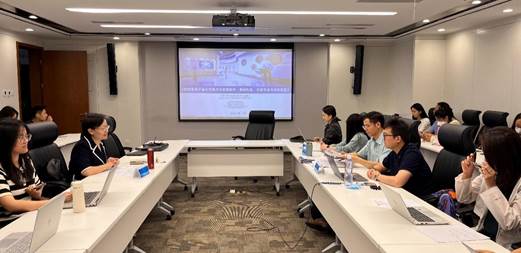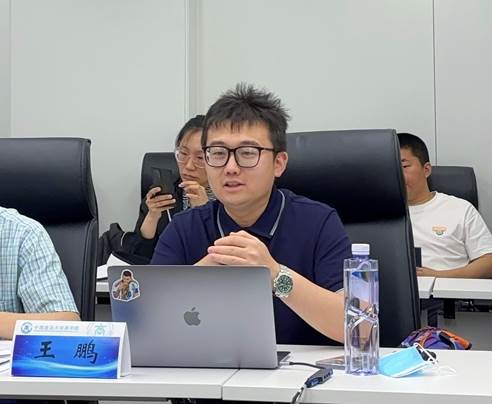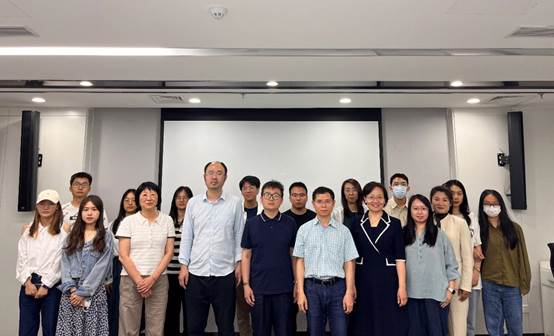On the morning of May 21, 2024, Dr. Wang Peng, associate researcher of Beijing Academy of Social Sciences, big data business analyst, senior network public opinion analyst, and data asset appraiser, was invited by our institute to give a lecture entitled "The difficulty and development path of data element value: basic system, key node and future prospect" for teachers and students in Conference Room 0813 of the comprehensive Building. Professor Liu Zhixiong, Vice Dean of the Business School, delivered a speech at the forum. Professor Li Chao, director of the Department of Industrial Economics of the Business School, presided over the forum. Associate Professor Cong Yingnan, deputy director of the Department of Industrial Economics of the Business School, participated in the forum.

(Picture The 42nd lecture of "Legal Business Academic Forum" of Business School)
Vice Dean Liu Zhixiong extended a warm welcome to Dr. Wang Peng, thanked Dr. Wang for coming to China University of Political Science and Law Business School to share the lecture, and looked forward to more in-depth and close exchanges with Dr. Wang in the future.
In the lecture stage, Dr. Wang Peng introduced the non-scarcity, non-homogeneity and non-exclusivity of data elements from the three state characteristics of data elements. At this stage, a data fragmentation situation has been formed, in which organizations, enterprises or government agencies are relatively independent in data collection, storage and use, and lack effective data sharing and circulation mechanisms among each other. "Data giants" such as public management and public service institutions, large digital platform enterprises, and industry monopoly leading enterprises hold a large amount of data resources. However, the public and micro, small and medium-sized enterprises have less data production means. Therefore, we should play the role of the government, flow the data resources held by "big data users" to the public and micro, small and medium-sized enterprises through market-oriented means, so as to realize the return of the number to the people, empower the digital development of micro, small and medium-sized enterprises, and increase the sense of data wealth of the enterprise masses, which is the focus of cracking the data factors.

(Picture Shared by Dr. Wang Peng)
Then, Dr. Wang Peng sorted out the important policies related to data elements, focusing on the interpretation of the Ministry of Finance's "Guiding Opinions on Strengthening Data Asset Management" (hereinafter referred to as the "Guiding Opinions"). The "Guiding Opinions" proposed to promote all people to share the dividend of the digital economy, fully release the value of data assets as the goal, to promote the compliance and efficient circulation and use of data assets as the main line, orderly promote data assets, strengthen the whole process management of data assets, and better play the value of data assets. The "Guiding Opinions" have defined 12 key tasks for strengthening data asset management. It covers the management of data assets in accordance with law and compliance, clarifying the relationship between rights and responsibilities of data assets, improving relevant standards for data assets, strengthening the use and management of data assets, steadily promoting the development and utilization of data assets, improving the value evaluation system of data assets, unblocking the income distribution mechanism of data assets, standardizing the destruction and disposal of data assets, strengthening the monitoring of data assets process, strengthening the emergency management of data assets, and improving Data asset information disclosure and reporting, strict prevention of data asset value application risks and other aspects.
Finally, Dr. Wang Peng introduced the typical scenarios of data element value release, including helping enterprises to improve quality, reduce cost and increase efficiency, realizing enterprise data assets, public data value circulation and industrial data ecological operation; The main innovative application directions of data assets are summarized, including data asset credit enhancement, data asset transfer, data asset investment, data asset pledge financing, data asset factoring, data asset trust, data asset insurance and data asset securitization.

(Picture Group photo of teachers and students attending the meeting)
At the end of the meeting, the teachers and students shared their feelings and thoughts, and asked Dr. Wang Peng questions.
The 42nd lecture of the "Legal Business Academic Forum" of the Business School was co-organized by the Department of Industrial Economics. Through this lecture, we have a more comprehensive understanding of the core concepts such as data elements, data rights, data assets into the table; I have a deeper understanding of the basic system, key nodes and future development of the value of data elements.